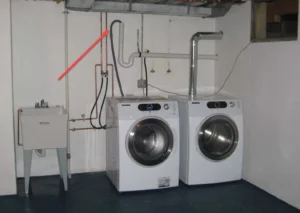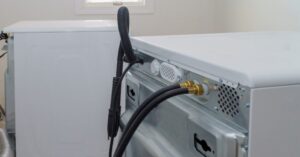As an Amazon Associate I earn from qualifying purchases.

Washing machine drainage Options is an essential part of the laundry process. It involves removing the dirty water and detergent from the machine after each wash cycle. There are several drainage options available for washing machines, and the choice depends on your plumbing setup and preferences. Here are some common washing machine drainage options explained:
Washing Machine Drainage Options Standpipe or Utility Sink
Standpipe: A standpipe is a vertical pipe that extends above the level of the washing machine. It typically has a P-trap to prevent sewer gasses from entering your home. The washing machine drain hose is inserted into the standpipe, allowing wastewater to flow into the drain system. Make sure the standpipe is at least 18 inches high, but not more than 30 inches
Utility Sink: If you have a utility sink in your laundry area, you can connect the washing machine drain hose directly to the sink’s drain. This setup is convenient for draining and allows you to use the sink for other purposes as well.


Washing Machine Drainage Options Floor Drain
If you have a floor drain in your laundry area, you can direct the washing machine drain hose to the floor drain. Ensure that the hose is securely fastened to prevent it from coming loose during the wash cycle.
Washing Machine Drainage Options Direct to Sewer Line
In some homes, the washing machine drain hose may be directly connected to the home’s sewer line. This setup requires professional installation and may not be possible in all homes.
Washing Machine Laundry Sink Drainage
If you have a laundry sink next to your washing machine, you can connect the washing machine drain hose to the sink’s plumbing system. This is similar to using a utility sink for drainage.
Washing Machine External Pump
In cases where the washing machine is located far from existing drain options, an external pump may be installed to pump the wastewater to a suitable drain or sewer line. This is a more complex and expensive option but can be necessary in certain situations.
Washing Machine Dry Well
In some rural or remote areas, a dry well may be used for washing machine drainage. A dry well is a large, underground container that collects and disperses wastewater into the ground. This method requires proper permits and adherence to local regulations.
Regardless of the drainage option you choose, it’s a good idea to use a lint filter on the washing machine hose. This helps prevent lint and debris from clogging the drain system.
When selecting a drainage option for your washing machine, consider the local plumbing codes and regulations, the location of your washing machine relative to existing plumbing fixtures, and the ease of installation. It’s often recommended to consult a professional plumber or follow the manufacturer’s guidelines for proper installation to ensure efficient drainage and prevent plumbing issues.
Amazon and the Amazon logo are trademarks of Amazon.com, Inc, or its affiliates.

